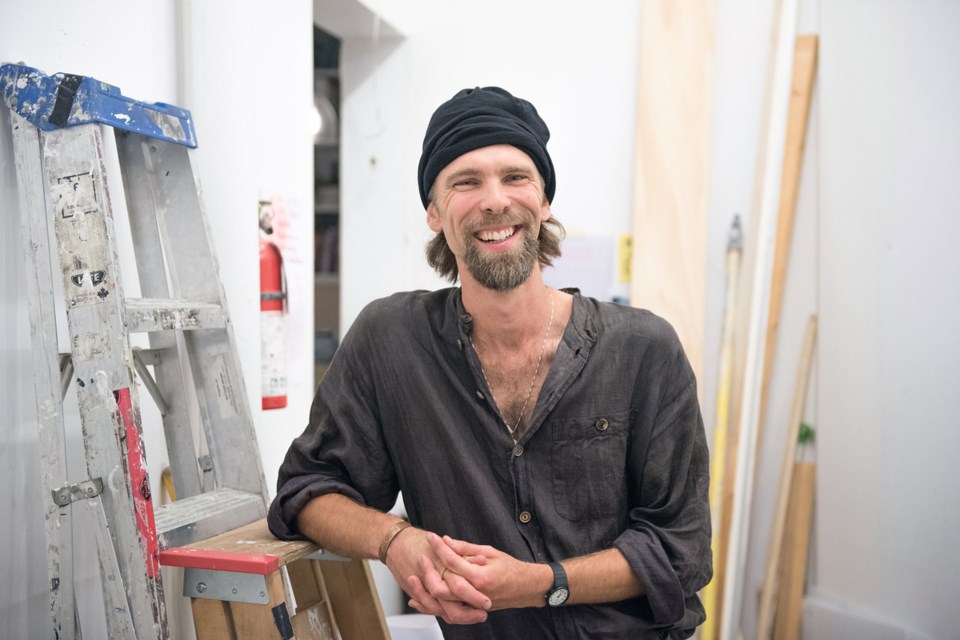The ocean’s unpredictability provided favourable conditions for the creative minds selected for Access Gallery’s travelling artist residency.
Four emergent artists, part of the project titled “Twenty-Three Days at Sea, Chapter Two,” sailed one at a time over the last 12 months across the Pacific from Â鶹´«Ă˝Ół»to Shanghai on a container ship.
The artist residencies were hosted by Access Gallery in partnership with the Burrard Arts Foundation and Contemporary Art Gallery. The lineup of the second version (Chapter One took place in 2015) included Â鶹´«Ă˝Ół»artist Michael Drebert whose practice involved tossing clam shells he collected from local beaches overboard the ship off the coast of Japan.
Before his residency, Drebert, a graduate of Emily Carr University of Art + Design, learned the common purple varnish clams he found on local beaches are not in fact native to B.C. waters. The nuttalia obscurata clam arrived in Â鶹´«Ă˝Ół»accidentally, transported in the ballast water of container ships traveling from Asia (it is not considered to be invasive because it is not known to threaten local organisms).
Drebert, a gatherer inspired by a curiosity of the natural world, decided to return his collection of purple varnish clams to their home waters. That was the first part of his durational project “Purple Shells.”
Following “Movement #1 (returning)” is “Movement #2 (cleaning)” where he revisits the same beaches to clean them up of garbage. He does this daily for the duration of the exhibition that wraps Oct. 28.
“I love — I’m in love with the West Coast,” said Drebert during Friday’s opening. “I’m doing something that needs to be done. It’s not universe changing but it leads to the next thing and it occupies the mind in a useful way.”
The only trace of Drebert’s work in the confines of the gallery walls is his logbook, fulfilling one of two residency obligations. Along with producing a body of work, each of the residency artists agreed to provide a daily record of their crossing.
Accompanying a sound piece called “Borrowed Time,” which examines the role of music aboard the ship, Toronto-based multi-disciplinary artist Lili Huston-Herterich recreated the form of a wooden screen that was used to separate dining from leisure spaces in the ship’s mess hall as well as to divide areas between the Filipino crew and the French officers. Huston-Herterich’s screen was made from cotton T-shirts that were used as grease rags to lubricate the ship’s engine room.
Sikarnt Skoolisariyaporn, an artist based in London, UK and Bangkok, Thailand, also produced two intertwining pieces. One, a performance titled “Object without Shadow,” examines the notion of ghosts in her Thai-Chinese culture; and the other, a single-channel video called “Unexploded Ordnance,” inspired by the repetitive surroundings of the ship.
Perhaps the most publicized artist of the exhibition is London-based artist Rebecca Moss whose September 2016 voyage on the Hanjin Geneva was unexpectedly extended because the shipping company filed for receivership.
Going bankrupt meant ports were closed off to the hundred Hanjin ships that had no other option other than to drop anchor and wait for instruction.
Since Moss’s artistic practice surrounds itself with the comedic and absurd, she included the experience of being thrown into the role of the human face of the economic shipping disaster.
In her video “International Waters,” she looked at the absurdities within the global shipping industry, and included a visual of a satellite email exchange she had with somebody concerned about their shipment of frozen French fries. After Moss reassured the person the fries were being kept cold, she received this response: “OK, thanks for replying! I hope you hear news soon. This is an incredible story and you’re getting a unique view on globalization.”
Moss and her fellow slow-travel passengers disembarked in Tokyo two days after the ship was scheduled to dock in Shanghai.
While the traveling residency was born out of necessity, the unpredictability that occurs in a predictable seascape of an ocean horizon was something that fascinated Access Gallery curator Kimberly Philips.
The plan came about when Philips, working within the financial constraints that plague most small, artist-run galleries, realized hosting a residency in a traditional studio was out of the question with the city’s costly rents. So she started researching shipping companies that took on travellers (known in the industry as super cargo). While the ships used for Chapter Two residency were from different companies, they are operated through a German management company, NSB Reiseboro.
“We can’t host artists on terra firma so what else can we do? We can send them off to sea,” she said.
The exhibition’s end next month also marks the end of the container ship residency project. After four years, Philips has moved from Access to her new curator role at CAG, but she hopes “Twenty-Three Days at Sea” will live on in the form of a tour with the works from both residencies.
@rebeccablissett



